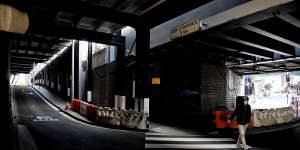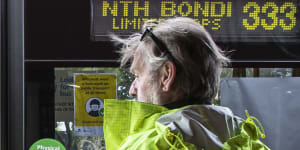The number of people on public transport was about eight per cent of pre-COVID levels,according to new NSW government figures,a sign that the latest restrictions had likely had an immediate impact on mobility across the city. Road traffic also decreased by more than 45 per cent.

An empty street in Parramatta on Monday.Nick Moir
New restrictions announced over the weekend included a ban on all non-urgent,, stopping residents from leaving Fairfield,Liverpool and Canterbury-Bankstown unless they were essential workers and by up to 50 per cent.
University of Sydney transport expert Geoffrey Clifton said it had been more than a century since so few people had used public transport in the harbour city.
“We have to go back to the 1800s to see a time when regular public transport patronage was this low,” he said,citing data from the Australian Bureau of Statistics and Bureau of Infrastructure and Transport Research Economics (BITRE).
“The drop off since last week shows the importance of the construction industry to Sydney’s economy.”

Some essential workers were still relying on the city’s public transport network on Monday.Louie Douvis
Transport for NSW chief operations officer Howard Collins said the department was monitoring Opal card data and CCTV cameras and would make changes to the network if any crowding took place on the reduced services.
“Patronage across public transport was at about eight per cent of pre-COVID levels,the lowest patronage we have seen throughout the pandemic,” Mr Collins said.
Eight per cent of pre-COVID levels equates to between 50 and 60 million trips per year,which has not been seen in more than 120 years,Dr Clifton said.
An Australasian Transport Research Forum paper based on BITRE data tracked patronage back to 1900,with NSW recorded as having 120 million trips that year. That public transport data also included the use of “horse-drawn vehicles”.
While most of the network was close to deserted on Monday,the cuts to all public transport modes meant the few essential workers who were still travelling were relying on fewer services.
Registered nurse Molly Cocks said one bus service she used to get to her work in Sydney’s inner west was busier than it had been at any point during the most recent lockdown.
“That bus stop was full. Close to 20 people got on one bus going up Parramatta Road,” Ms Cocks said,adding that she didn’t get on due to social distancing concerns. “Obviously we don’t need all of them,but a few more would be very helpful.”
Dr Clifton said the government’s move to decrease services by between 30 and 50 per cent for at least two weeks had proven effective,but also posed new risks.
“By shifting to a weekend timetable there is a risk that there will be more people on each bus and train but the government is hoping that people will stay at home and so far people are following government advice,” he said. “It also means they can keep a reliable service operating even though many public transport staff are in isolation themselves.”
All government-employed transport staff will continue to receive their rostered earnings,with Transport for NSW recommending that private operators do the same.
Opposition transport spokeswoman Jo Haylen said the low patronage was a good sign people were adhering to restrictions,but the government needed to guarantee essential workers could still move around the city.
”[The Transport Minister] must guarantee that when essential workers are trying to get to work,or people are going to get tested or vaccinated that they can rely on their local bus,train or ferry service and can travel in a COVID- safe way,” she said.
Labor member for Coogee Marjorie O’Neill said the government needed to put more consideration into the number of essential workers impacted by its public transport cuts.
“Many health workers in my community have contacted me with grave concerns about the reduction in bus services,” she said. “Fewer services will mean that more essential health care workers will be squeezed onto each bus,putting both them and the other passengers at risk.“
The Morning Edition newsletter is our guide to the day’s most important and interesting stories,analysis and insights..